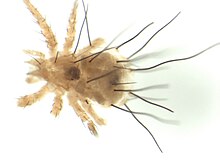Horn mites
| Horn mites | ||||||||||
|---|---|---|---|---|---|---|---|---|---|---|

Horn mite from the family Phthiracaridae |
||||||||||
| Systematics | ||||||||||
|
||||||||||
| Scientific name | ||||||||||
| Oribatida | ||||||||||
| Dugès , 1834 |

The horn mites (Oribatida), also called moss, beetle or tank mites , are an order of mites that live mainly in humus and soil, but also in moist moss and rarely in water. They play an important role in litter decomposition .
Systematics
The order of the horn mites is extremely rich in species and shapes. Fossils show that this group of animals was found in Devonian some 380 million years ago . Today around 10,000 horn mite species are known worldwide, of which around 60 families with 400 species can be found in Germany.
anatomy
Most species are heavily armored and spherical in shape. This serves to protect against enemies and against dehydration. The spherical protective position can be reinforced by placing the legs in recesses in the body or by covering the legs with wing-like appendages of the hysterosoma . The drawing-in of the legs into the body and their covering by the rostrum is called ptychoidia .
The German names of the Oribatida mentioned at the beginning refer to the similarity with beetles or the strong armor (or also to the habitat of moss ) and are therefore not applicable to the whole order.
The species of the families Damaeidae and Neoliodidae are predominantly large and have relatively long legs. They usually live in loose litter and moss and protect themselves by carrying old stripped larvae or nymph skins with them on their backs. This protection package is often also encrusted with dirt particles .
The species of the Brachychthoniidae family , which need moisture, are barely or not at all armored. The animals look whitish because they have little chitin .
nutrition
Horn mites eat parts of plants such as leaves, depending on the type; they are more rarely predatory or scavengers. From a nutritional point of view, they are divided into 3 different groups according to their feed. The macrophytophagous species feed only on macrophytic waste, the microorganisms such as algae, bacteria and fungi, and the third group of panphytophagous species feed on mixed foods as non-specialists. Horn mites account for 70 to 90% of the ground-dwelling mites. They live in the litter and in the upper soil layer up to 5 cm (maximum 10 cm) soil depth. Here they endure both dryness and wetness. Because of their tolerance to low pH values , horn mites are among the most important litter decomposers in highly acidic forest soils. They can eat 10 to 20% of the annual waste. The cellulose and lignin are broken down by microorganisms in the mites' intestines.
The density of individuals on one square meter of forest floor can be 20,000 to 50,000 animals. This would correspond to a live weight of 8 to 20 kg per hectare .
Others
Some horn mites serve as intermediate hosts of various tapeworms ( Moniezia , Anoplocephala, and others) that parasitize on domestic or wild animals. For example, cows or horses become infected when they graze in damp pastures and swallow horn mites. For the Monieziose of ruminants alone 20 kinds of Horn mites as intermediate hosts are known.
Many types of horn mite can synthesize fat-soluble alkaloids , which are toxic. Various small frog species, including the poison dart frogs , ingest these poisons with their food, which consists to a large extent of horn mites, this is referred to as sequestration of the poisons . You can convert these substances, usually pumiliotoxins , so that they do not harm them and can be released through the skin. The poisons serve these frogs as protection against bacteria and fungi and keep predators away.
Many genera and species of the superfamily Analgoidea parasitize on the feathers of birds and are therefore called feather mites . However, feather mites can also come from other groups of mites that are not closely related to horn mites.
See also
- Family Achipteriidae
Individual evidence
- ^ David Evans Walter: Forest Canopies . Ed .: Margaret Lowman, H. Bruce Rinker. Academic Press , 2004, ISBN 978-0-12-457553-0 , Hidden in plain sight: mites in the canopy, p. 224–241 ( limited preview in Google Book search).
- ↑ Zhi-Qiang Zhang, Xiao-Yue Hong, Qing-Hai Fan, Jie-Liu Xin: Xin Jie-Liu Centenary: Progress in Chinese Acarology . In: Zoosymposia . tape 4 , 2010, ISSN 1178-9905 .
- ^ GW Krantz, DE Walter (Ed.): A Manual of Acarology 3rd Edition . Texas Tech. University Press, 2009, Astigmatina. Chapter 16.
- ↑ Information Service Science
- ^ Paul Brohmer : Fauna of Germany. 18th edition, Heidelberg 1992, ISBN 3-494-01200-8 , p. 153
- ^ Heinrich Schatz: About nutritional biology of Oribatiden (Acari) in the high mountains. 1979 (PDF; 851 kB)
- ↑ (Script for the lecture, University of Kassel) ( Memento from August 13, 2012 in the Internet Archive ) (PDF; 5.7 MB)
- ↑ Johannes Eckert, Karl Theodor Friedhoff, Horst Zahner, Peter Deplazes: Textbook of Parasitology for Veterinary Medicine. 2nd edition, Enke-Verlag, 2008, p. 194ff at Google Books
- ↑ Ariel Rodríguez, Dennis Poth, Stefan Schulz and Miguel Vences: Discovery of skin alkaloids in a miniaturized eleutherodactylid frog from Cuba. Biology Letters, Royal Society Publishing, online publication on November 3, 2010 doi : 10.1098 / rsbl.2010.0844 full text (PDF, English)
literature
- Wolfram Dunger: Animals in the soil. Die Neue Brehm-Bücherei Vol. 327, A. Ziemsen Verlag, Wittenberg Lutherstadt, 1983, ISSN 0138-1423
- Gerald W. Krantz, David E. Walter (Eds.): A Manual of Acarology. 3rd edition. Texas Tech University Press, Lubbock TX 2009, ISBN 978-0-89672-620-8 . Pp. 430-564.
Web links
- Welcome to the world of horn mites (Oribatida) - Global Biodiversity Information Facility
- Peter Wohlleben , The secret power of the horn mite , in: Zeit Wissen 4/2017